2006 SUBARU BAJA weight
[x] Cancel search: weightPage 246 of 487
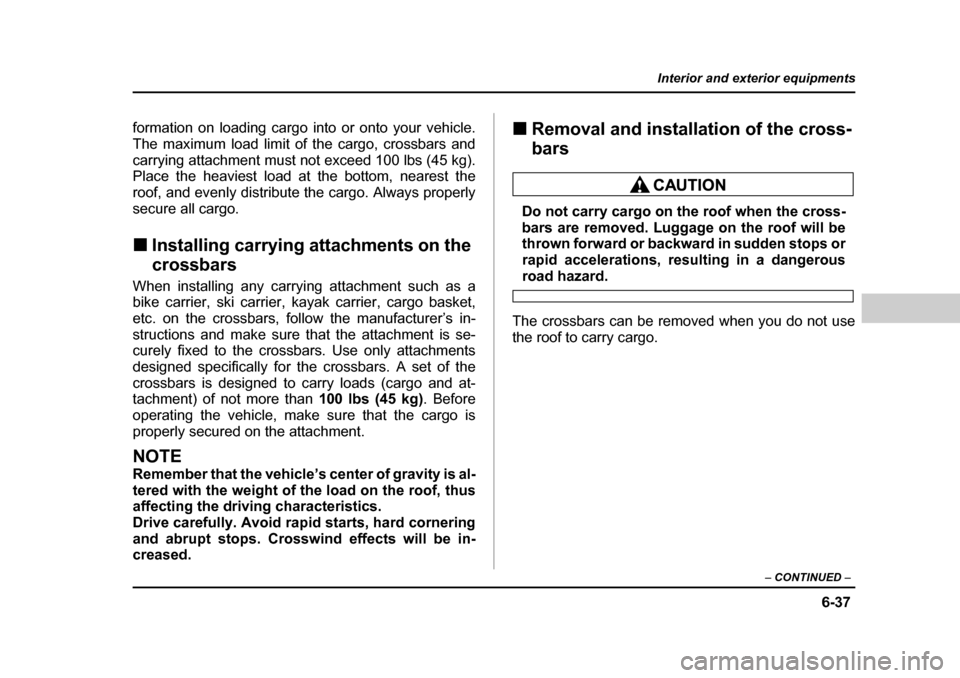
6-37
Interior and exterior equipments
– CONTINUED –
formation on loading cargo into or onto your vehicle.
The maximum load limit of the cargo, crossbars and
carrying attachment must not exceed 100 lbs (45 kg).
Place the heaviest load at the bottom, nearest the
roof, and evenly distribute the cargo. Always properlysecure all cargo. �„Installing carrying attachments on the crossbars
When installing any carryi ng attachment such as a
bike carrier, ski carrier, ka yak carrier, cargo basket,
etc. on the crossbars, foll ow the manufacturer’s in-
structions and make sure th at the attachment is se-
curely fixed to the crossbars. Use only attachments
designed specifically for the crossbars. A set of the
crossbars is designed to carry loads (cargo and at-
tachment) of not more than 100 lbs (45 kg). Before
operating the vehicle, make sure that the cargo is
properly secured on the attachment.
NOTE
Remember that the vehicle’s center of gravity is al-
tered with the weight of the load on the roof, thus
affecting the driving characteristics.
Drive carefully. Avoid rapid starts, hard cornering
and abrupt stops. Crosswind effects will be in-
creased. �„
Removal and installation of the cross- bars
Do not carry cargo on the roof when the cross-
bars are removed. Luggage on the roof will be
thrown forward or backward in sudden stops or
rapid accelerations, resulting in a dangerous
road hazard.
The crossbars can be removed when you do not use
the roof to carry cargo.
Page 294 of 487

8-1
8
Driving tips
New vehicle break-in driving – the first 1,000 miles (1,600 km) .... ....................... .... 8-2
Fuel economy hints ...................................... 8-2
Engine exhaust gas (Carbon monoxide) .... 8-3
Catalytic converter .......... .............................. 8-4
Periodic inspections ..................................... 8-6
Driving in foreign countrie s ......................... 8-6
Driving tips for AWD vehicles ...................... 8-7
Off road driving ............................................. 8-9
Winter driving ................................................ 8-11 Operation during cold weather ........................ 8-11
Driving on snowy and icy roads ...................... 8-13
Corrosion protection ........................................ 8-15
Snow tires .......................................................... 8-15
Tire chains ......................................................... 8-16
Rocking the vehicle .......................................... 8-16
Loading your vehicle .................................... 8-17 Vehicle capacity weight ................................... 8-19
GVWR and GAWR (Gross Vehicle Weight Rating and Gross Axle Weight Rating) ........ 8-19
Trailer hitch (if equipped) ............................. 8-20 Connecting a trailer .......................................... 8-21
When you do not tow a trailer ......................... 8-24
Trailer towing ................................................ 8-25 Warranties and maintenance ........................... 8-25
Maximum load limits ........................................ 8-25
Trailer hitches ................................................... 8-30
Connecting a trailer .......................................... 8-31
Trailer towing tips ............................................. 8-33
Page 312 of 487
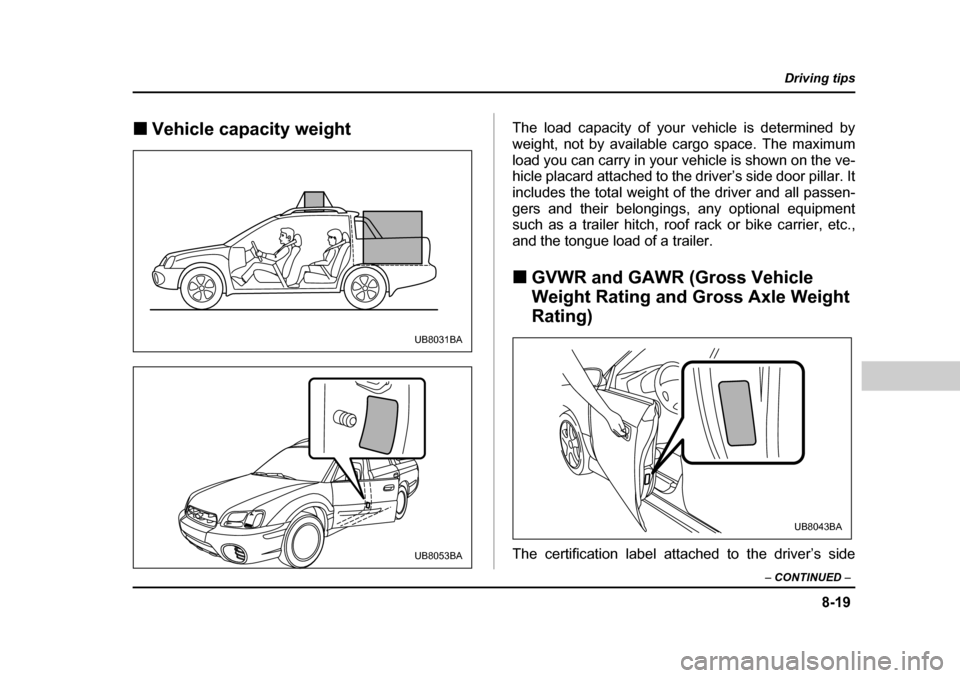
8-19
Driving tips
– CONTINUED –
�„Vehicle capacity weight The load capacity of your vehicle is determined by
weight, not by available cargo space. The maximum
load you can carry in your
vehicle is shown on the ve-
hicle placard attached to the driver’s side door pillar. It
includes the total weight of the driver and all passen-
gers and their belongings, any optional equipment
such as a trailer hitch, roof rack or bike carrier, etc.,
and the tongue load of a trailer. �„ GVWR and GAWR (Gross Vehicle
Weight Rating and Gross Axle Weight Rating)
The certification label atta ched to the driver’s side
UB8031BA
UB8053BA
UB8043BA
Page 313 of 487

8-20
Driving tips
door shows GVWR (Gross Vehicle Weight Rating)
and GAWR (Gross Axle Weight Rating).
The GVW (Gross Vehicle Weight) must never exceed
the GVWR. GVW is the combined total of weight of the
vehicle, fuel, driver, all
passengers, luggage, any op-
tional equipment and trailer tongue load. Therefore,
the GVW changes depending on the situation.
In addition, the total weight applied to each axle
(GAW) must never exceed the GAWR. The front and
rear GAWs can be adjusted by relocating luggage in- side the vehicle.
Even if the total weight of your luggage is lower than
the vehicle capacity weight, either front or rear GAW
may exceed the GAWR, depending on the distribution
of the luggage.
When possible, the load should be evenly distributed
throughout the vehicle.
If you carry heavy loads in the vehicle, you should con-
firm that GVW and front and rear GAWs are within the
GVWR and GAWR by putting your vehicle on a vehi-
cle scale, found at a commercial weighing station.
Do not use replacement tires with a lower load range
than the originals because they may lower the GVWR
and GAWR limitations. Replacement tires with a high-
er load range than the originals do not increase the
GVWR and GAWR limitations.Trailer hitch (if equipped)
�y Never exceed the maximum weight specified
for the trailer hitch. Exceeding the maximum
weight could cause an accident resulting in se-
rious personal injuries. Permissible trailer
weight changes depending on the situation. Re-
fer to the next section “Trailer towing” for pos-
sible recommendations and limitations. �y Trailer brakes are required when the towing
load exceeds 1,000 lbs (453 kg). Be sure your
trailer has safety chains and that each chain
will hold the trailer’s maximum gross weight.
Towing trailers without safety chains could cre-
ate a traffic safety hazard if the trailer separates
from the hitch due to coupling damage or hitch
ball damage. �y Be sure to check the hitch pin and safety pin
for positive locking placement before towing a
trailer. If the ball moun t comes off the hitch re-
ceiver, the trailer could get loose and create a
traffic safety hazard.�y Use only the ball mount supplied with this
hitch. Use the hitch only as a weight carrying
hitch. Do not use with any type of weight dis-
Page 314 of 487
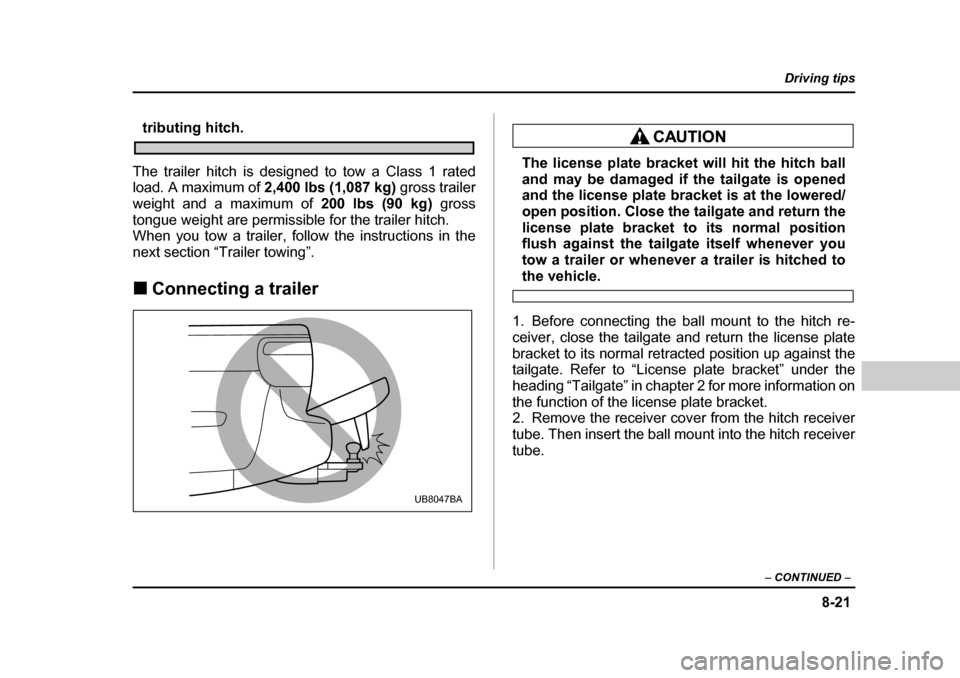
8-21
Driving tips
– CONTINUED –
tributing hitch.
The trailer hitch is designed to tow a Class 1 rated
load. A maximum of 2,400 lbs (1,087 kg) gross trailer
weight and a maximum of 200 lbs (90 kg) gross
tongue weight are permissible for the trailer hitch.
When you tow a trailer, follow the instructions in the
next section “Trailer towing”. �„ Connecting a trailer
The license plate bracket will hit the hitch ball
and may be damaged if the tailgate is opened
and the license plate bracket is at the lowered/
open position. Close the tailgate and return the
license plate bracket to its normal position
flush against the tailgate itself whenever you
tow a trailer or whenever a trailer is hitched to
the vehicle.
1. Before connecting the ball mount to the hitch re-
ceiver, close the tailgate and return the license plate
bracket to its normal retracted position up against the
tailgate. Refer to “License plate bracket” under the
heading “Tailgate” in chapter 2 for more information on
the function of the license plate bracket.
2. Remove the receiver cover from the hitch receiver
tube. Then insert the ball mount into the hitch receiver
tube.
UB8047BA
Page 316 of 487
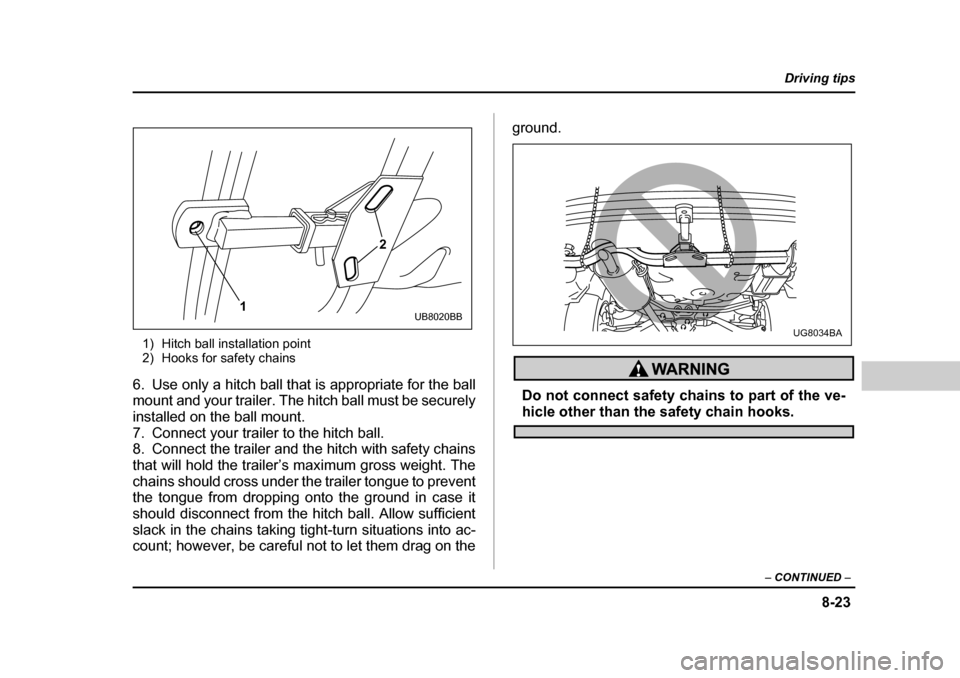
8-23
Driving tips
– CONTINUED –
1) Hitch ball installation point
2) Hooks for safety chains
6. Use only a hitch ball that is appropriate for the ball
mount and your trailer. The hitch ball must be securely
installed on the ball mount.
7. Connect your trailer to the hitch ball.
8. Connect the trailer and the hitch with safety chains
that will hold the trailer’s maximum gross weight. The
chains should cross under the trailer tongue to prevent
the tongue from dropping onto the ground in case it
should disconnect from the hitch ball. Allow sufficient
slack in the chains taking tight-turn situations into ac-
count; however, be careful not to let them drag on the ground.
Do not connect sa
fety chains to part of the ve-
hicle other than the safety chain hooks.
1 2UB8020BBUG8034BA
Page 318 of 487

8-25
Driving tips
– CONTINUED –
Trailer towing
Your vehicle is designed and intended to be used pri-
marily to carry passengers and cargo. Towing a trailer
puts additional loads on your vehicle’s engine, driv-
etrain, brakes, tires and suspension and has an ad-
verse effect on fuel economy.
If you do decide to tow a trailer, your safety and satis-
faction depend upon proper use of correct equipment
and cautious operation of yo ur vehicle. Seek the ad-
vice of your SUBARU dealer to assist you in purchas-
ing a hitch and other necessary towing equipment ap-
propriate for your vehicle. In addition, be sure to follow
the instructions on correct installation and use provid-
ed by the trailer and other towing equipment manufac-
turers.
SUBARU assumes no responsibi lity for injuries or ve-
hicle damage that result from trailer towing equipment,
or from any errors or omissions in the instructions ac-
companying such equipment or for your failure to fol-
low the proper instructions. �„ Warranties and maintenance
SUBARU warranties do not apply to vehicle damage
or malfunction caused by trailer towing. If you use your
vehicle to tow a trailer, more frequent maintenance will
be required due to the additional load. (Refer to “Main- tenance schedule under severe driving conditions” in
the “Warranty and Maintenance Booklet”.)
Under no circumstances should a trailer be towed with
a new vehicle or a vehicle with any new powertrain
component (engine, transmis
sion, differential, wheel
bearings, etc.) for the first 1,000 miles (1,600 km) of
driving. �„ Maximum load limits
Never exceed the maximum load limits ex-
plained in the following. Exceeding the maxi-
mum load limits could cause personal injury
and/or vehicle damage.
�yAdequate size trailer brakes are required
when the trailer and its cargo exceed 1,000 lbs
(453 kg) total weight. �y Before towing a tr ailer, check the trailer total
weight, GVW, GAWs and tongue load. Make
sure the load and its dist ribution in your vehicle
Page 319 of 487
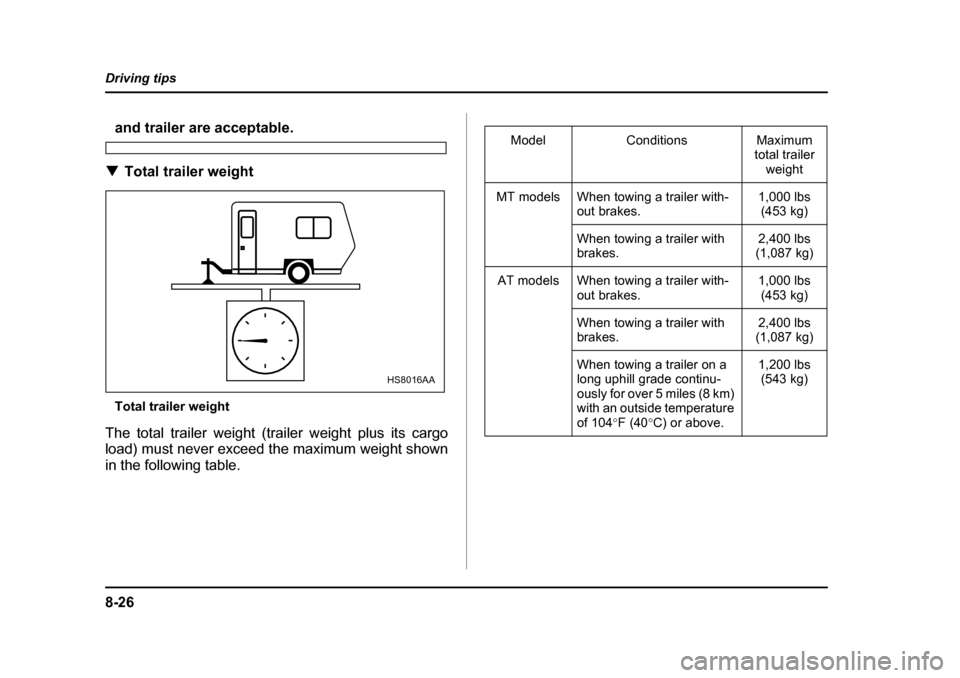
8-26
Driving tips
and trailer are acceptable.
�T Total trailer weight
Total trailer weight
The total trailer weight (trailer weight plus its cargo
load) must never exceed the maximum weight shown
in the following table.
HS8016AA
Model Conditions Maximum total trailer weight
MT models When towing a trailer with- out brakes. 1,000 lbs
(453 kg)
When towing a trailer with
brakes. 2,400 lbs
(1,087 kg)
AT models When towing a trailer with- out brakes. 1,000 lbs
(453 kg)
When towing a trailer with
brakes. 2,400 lbs
(1,087 kg)
When towing a trailer on a
long uphill grade continu-
ously for over 5 miles (8 km)
with an outside temperature
of 104 °F (40 °C) or above. 1,200 lbs
(543 kg)